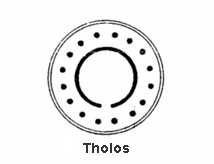
A tholos (pl.: tholoi; from Ancient Greek θόλος, meaning "conical roof"[1] or "dome"), in Latin tholus (pl.: tholi), is a form of building that was widely used in the classical world. It is a round structure with a circular wall and a roof, usually built upon a couple of steps (a podium), and often with a ring of columns supporting a conical or domed roof.
It differs from a monopteros (Ancient Greek:ὁ μονόπτερος from the Polytonic: μόνος, only, single, alone, and τὸ πτερόν, wing), a circular colonnade supporting a roof but without any walls, which therefore does not have a cella (room inside).[2] Both these types are sometimes called rotundas.

An increasingly large series of round buildings were constructed in the developing tradition of classical architecture until Late antiquity, which are covered here. Medieval round buildings are covered at rotunda. From the Renaissance onwards the classical tholos form had an enduring revival, now often topped by a dome, especially as an element in much larger buildings.
The tholos is not to be confused with the beehive tomb, or "tholos tomb" in modern terminology, a distinct form in Late Bronze Age Greece and other areas.[3] But many other round tombs and mausolea were built, especially for Roman emperors.
- ^ Lawrence, 183
- ^ Curl, James Stevens (2006). Oxford Dictionary of Architecture and Landscape Architecture, 2nd ed., OUP, Oxford and New York, p. 500. ISBN 978-0-19-860678-9.
- ^ Yarwood, 5–6
© MMXXIII Rich X Search. We shall prevail. All rights reserved. Rich X Search
